Therapeutic Guidelines Oral and Dental Version 3 is a comprehensive, evidence-based resource for dental professionals, offering practical recommendations for early detection and effective management of oral health conditions․
Overview of the Guidelines
Therapeutic Guidelines Oral and Dental Version 3 provides evidence-based recommendations for managing oral and dental conditions․ It focuses on early detection, diagnosis, and treatment of common dental issues, including caries, gum diseases, and infections․ The guidelines emphasize preventive care and maintenance, highlighting the importance of regular check-ups and proper oral hygiene practices․ Designed for dental professionals, the document offers practical advice on pharmacological interventions, antibiotic use, and tailored approaches for special populations․ It also addresses public health implications and the role of dental teams in promoting oral health․ Version 3 includes updated clinical protocols and new sections on emerging trends in dental care, making it a comprehensive resource for modern dental practice․
Importance of Oral and Dental Health
Oral and dental health is crucial for overall well-being, as it directly impacts quality of life, nutrition, and self-esteem․ Poor oral health can lead to conditions like dental caries, gum disease, and tooth loss, which are linked to systemic health issues such as diabetes and cardiovascular diseases․ Regular dental care prevents these conditions by promoting early detection and treatment․ The Therapeutic Guidelines Oral and Dental Version 3 emphasizes the importance of preventive measures, such as fluoride use and proper hygiene practices, to maintain optimal oral health․ By addressing these aspects, the guidelines aim to reduce the burden of oral diseases and improve public health outcomes, ensuring individuals can enjoy better health and well-being throughout their lives․
Structure and Content of Version 3
Therapeutic Guidelines Oral and Dental Version 3 is structured to provide clear, evidence-based information for dental professionals․ It is divided into sections covering common dental conditions, periodontal diseases, and oral infections, with detailed management strategies․ The guidelines include practical clinical applications, diagnostic approaches, and pharmacological interventions, ensuring comprehensive care․ Updates in Version 3 reflect the latest research and clinical practices, offering improved recommendations for patient assessment and treatment․ The content is designed to be user-friendly, with a focus on practical implementation, making it an essential tool for dentists and healthcare providers aiming to deliver high-quality, patient-centered care․
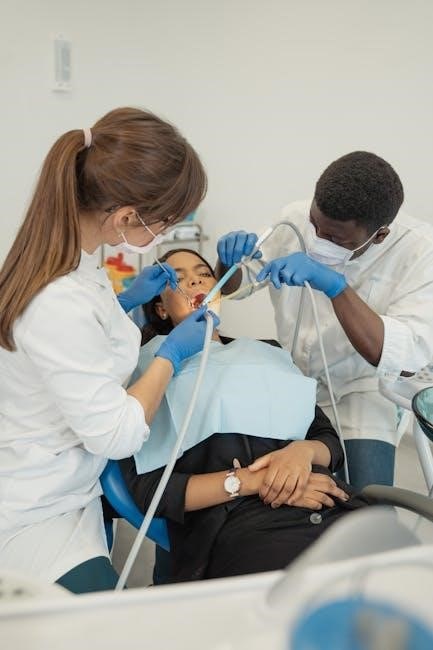
Key Features of Therapeutic Guidelines Oral and Dental Version 3
Version 3 offers evidence-based recommendations, updated clinical practices, and practical tools for managing oral and dental conditions, enhancing patient care with a focus on early detection and prevention․
New Updates and Changes in Version 3
Version 3 of the Therapeutic Guidelines Oral and Dental includes significant updates, such as revised recommendations for antibiotic use in oral infections and new protocols for periodontal disease management․ Additional chapters focus on preventive care, emphasizing fluoride’s role and the importance of regular dental check-ups․ The guidelines also incorporate recent research findings, ensuring evidence-based practices are reflected․ Furthermore, the structure has been streamlined for easier navigation, with practical tools and diagrams to aid clinicians․ These updates aim to enhance clinical decision-making, providing dentists and healthcare professionals with the most current and effective strategies for optimal patient outcomes․ This version underscores the commitment to advancing oral health care through continuous improvement and adherence to best practices․
Evidence-Based Recommendations
The Therapeutic Guidelines Oral and Dental Version 3 provides evidence-based recommendations, ensuring clinical decisions are grounded in the latest research and best practices․ These guidelines are developed through systematic review of high-quality evidence, prioritizing interventions proven to improve patient outcomes․ The recommendations address various oral and dental conditions, offering clear, actionable advice for diagnosis, treatment, and prevention․ They emphasize the importance of individualized care, considering patient-specific factors and preferences․ By adhering to these guidelines, dental professionals can deliver optimal, evidence-based care․ The document is regularly updated to reflect emerging research, ensuring it remains a reliable and authoritative resource for clinicians․ This approach fosters consistency and excellence in oral health care delivery․
Practical Clinical Applications
Therapeutic Guidelines Oral and Dental Version 3 is designed to support practical clinical applications, offering dentists and medical professionals actionable strategies for patient care․ The guidelines provide step-by-step approaches for diagnosing and managing common oral conditions, such as dental caries, periodontal diseases, and infections․ They also address pharmacological interventions and antibiotic use, ensuring safe and effective treatment․ Practical tools, including diagnostic algorithms and treatment flowcharts, are included to aid decision-making․ The emphasis is on translating evidence into real-world clinical scenarios, making it easier for practitioners to implement recommendations․ This focus on practical application ensures that the guidelines are not only theoretically sound but also clinically relevant, enhancing patient outcomes and streamlining dental practice workflows․

Oral and Dental Health Conditions Covered
Therapeutic Guidelines Oral and Dental Version 3 addresses a wide range of conditions, including dental caries, periodontal diseases, and oral infections, providing evidence-based management strategies․
Common Dental Conditions and Their Management
Therapeutic Guidelines Oral and Dental Version 3 provides detailed management strategies for common dental conditions such as dental caries, gum disease, and tooth loss․ These conditions are often preventable but can lead to significant oral health issues if left untreated․ The guidelines emphasize the importance of early detection through regular dental check-ups and the use of evidence-based treatments․ For dental caries, recommendations include fluoride applications and minimally invasive interventions․ Gum disease management focuses on scaling, root planing, and improving oral hygiene practices․ Tooth loss is addressed through restorative options like implants or dentures․ The document also highlights the role of patient education in preventing these conditions and promoting long-term oral health․ By adhering to these guidelines, dental professionals can deliver effective, personalized care tailored to individual patient needs․
Periodontal Diseases and Their Treatment
Periodontal diseases, such as gingivitis and periodontitis, are a key focus in Therapeutic Guidelines Oral and Dental Version 3․ The document provides evidence-based recommendations for their diagnosis and management․ Early-stage gingivitis is often reversible with improved oral hygiene and professional cleaning․ For advanced periodontitis, non-surgical approaches like scaling and root planing are emphasized․ Patient-specific factors, such as smoking and diabetes, are considered to tailor treatment plans․ The guidelines also address the role of antimicrobial therapy in severe cases, including the use of antibiotics like clindamycin․ Regular monitoring and maintenance are stressed to prevent disease progression and promote long-term oral health․ These recommendations aim to optimize outcomes for patients with periodontal conditions, ensuring effective and personalized care․
Oral Infections and Antibiotic Use
Therapeutic Guidelines Oral and Dental Version 3 provides detailed guidance on managing oral infections, emphasizing appropriate antibiotic use․ The document highlights the importance of distinguishing between bacterial, viral, and fungal infections to avoid unnecessary antibiotic prescriptions․ For bacterial infections, such as severe dental abscesses, antibiotics like amoxicillin or clindamycin are recommended, with considerations for patient allergies and resistance patterns․ The guidelines stress the need for dental professionals to balance effective infection control with minimizing antibiotic overuse, which contributes to resistance․ Additionally, the role of supportive care, including drainage and pain management, is addressed to ensure comprehensive treatment strategies for optimal patient outcomes and reduced complications․

Preventive Care and Maintenance
Preventive care is crucial for maintaining optimal oral health, emphasizing regular dental check-ups, proper oral hygiene practices, and the use of fluoride to prevent dental conditions․
Regular Dental Check-Ups and Their Importance
Regular dental check-ups are essential for maintaining oral health and preventing complications․ They allow early detection of issues like dental caries and gum disease, enabling timely intervention․ According to the Therapeutic Guidelines Oral and Dental Version 3, these visits help identify risks and monitor changes in the mouth․ Professionals can provide personalized advice, improving outcomes and reducing treatment costs․ Regular check-ups also promote better oral hygiene practices, fostering a proactive approach to health․ By emphasizing prevention, they play a vital role in overall well-being, aligning with evidence-based recommendations for effective dental care․ This approach ensures patients receive comprehensive, tailored support, enhancing long-term oral health and quality of life․ Regular dental check-ups are a cornerstone of preventive care, as highlighted in the guidelines․
Oral Hygiene Practices for Optimal Health
Effective oral hygiene practices are fundamental to achieving and maintaining optimal oral health․ The Therapeutic Guidelines Oral and Dental Version 3 emphasizes the importance of regular brushing with fluoride toothpaste, proper flossing, and the use of mouthwash to remove plaque and bacteria․ These practices help prevent dental caries, gum disease, and bad breath․ Additionally, limiting sugary and acidic foods reduces the risk of tooth decay․ The guidelines also recommend replacing toothbrushes every three months and ensuring correct brushing techniques․ By adhering to these practices, individuals can significantly lower their risk of oral health issues, promoting a healthy smile and overall well-being․ Consistent oral hygiene habits, as outlined in the guidelines, are crucial for long-term dental health and preventing costly treatments․
Role of Fluoride in Preventive Dental Care
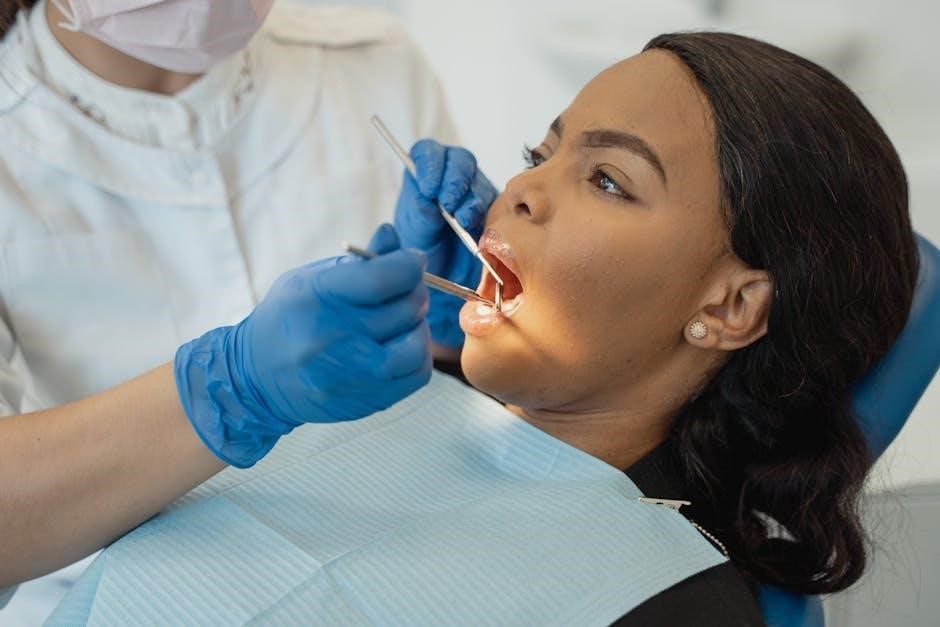
Fluoride plays a pivotal role in preventive dental care by strengthening tooth enamel and preventing decay․ According to the Therapeutic Guidelines Oral and Dental Version 3, fluoride helps remineralize teeth, making them more resistant to acid attacks from plaque and bacteria․ Regular use of fluoride toothpaste and mouthwash can significantly reduce the incidence of cavities․ Additionally, community water fluoridation has been proven to enhance oral health on a population level․ The guidelines highlight fluoride’s ability to reverse early signs of tooth decay, making it a cornerstone of preventive dental strategies․ By promoting fluoride use, dental professionals can help patients maintain healthy teeth and gums, reducing the need for invasive treatments and improving overall oral health outcomes․

Diagnostic and Treatment Approaches
Diagnostic approaches include clinical examinations and tests to identify oral and dental issues early․ Treatment focuses on evidence-based interventions, including pharmacological options, tailored to patient needs for optimal outcomes․
Clinical Examination and Diagnostic Tests
Clinical examinations are crucial for identifying oral and dental issues․ They involve visual inspections, palpations, and radiographic imaging to detect conditions like caries, periodontal disease, and infections․ Diagnostic tests may include microbiological assessments and histopathological evaluations for precise diagnoses․ These methods ensure early detection, enabling timely interventions․ The guidelines emphasize the importance of combining clinical judgment with diagnostic tools for accurate assessments․ Regular check-ups and the use of advanced imaging technologies, such as digital X-rays, enhance diagnostic accuracy․ By integrating these approaches, dental professionals can provide personalized care, improving patient outcomes and preventing complications․ Effective use of diagnostic tools is a cornerstone of modern dental practice, as outlined in the therapeutic guidelines․
Medical History and Its Relevance in Dental Care
A patient’s medical history is vital in dental care as it helps identify systemic conditions that may influence oral health and treatment․ For instance, diabetes can increase the risk of periodontal diseases, while heart conditions may require antibiotic prophylaxis before procedures․ Additionally, medications such as bisphosphonates can impact dental treatments․ The therapeutic guidelines emphasize the importance of reviewing medical histories to tailor dental care appropriately, ensuring patient safety and optimal outcomes․ By considering factors like allergies, bleeding disorders, and immunocompromised states, dentists can avoid complications and deliver personalized care; This holistic approach underscores the interconnection between overall health and dental well-being, making medical history a critical component of comprehensive dental management․ Accurate and detailed medical histories are essential for effective treatment planning․
Pharmacological Interventions in Dental Practice
Pharmacological interventions play a crucial role in dental practice, addressing pain, infection, and anxiety․ Analgesics and NSAIDs are commonly prescribed for pain management, while antibiotics like amoxicillin or clindamycin are used for bacterial infections․ The therapeutic guidelines emphasize evidence-based prescribing, ensuring medications are tailored to patient needs and medical histories․ For instance, patients with heart conditions may require antibiotic prophylaxis․ Additionally, anxiolysis medications are used to alleviate dental anxiety․ Proper dosing and contraindications must be considered to avoid adverse effects․ The guidelines also highlight the importance of antibiotic stewardship to combat resistance․ By adhering to these recommendations, dentists can optimize treatment outcomes while minimizing risks, ensuring safe and effective pharmacological interventions in daily practice․
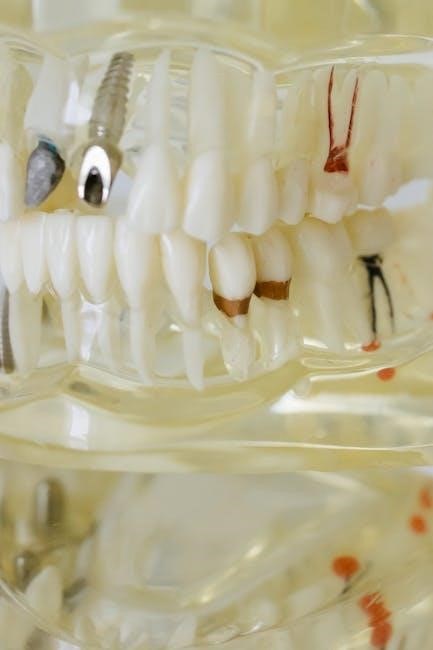
Special Populations and Oral Health
Special populations, including the elderly and medically compromised, require tailored oral health strategies․ The guidelines address their unique needs, emphasizing prevention and treatment adjustments for optimal care․

Oral Health in Children and Adolescents
Oral health in children and adolescents is crucial for overall well-being․ The guidelines emphasize early dental visits, preventive care, and education on proper hygiene practices․ Regular check-ups help identify issues like tooth decay and misalignment early, ensuring timely interventions․ Fluoride therapy and sealants are recommended to protect developing teeth․ Dietary advice is also provided to limit sugary foods and drinks, reducing caries risk․ Parents and caregivers play a vital role in fostering good habits․ Special considerations are given for children with special needs, ensuring tailored approaches․ The guidelines aim to promote lifelong oral health, addressing unique challenges during growth and development․ By prioritizing early care, the foundation for a healthy smile is established, preventing future complications and enhancing quality of life․
Dental Care for the Elderly and Vulnerable Populations
Dental care for the elderly and vulnerable populations requires specialized attention due to increased risks of oral health issues․ Factors such as reduced dexterity, chronic illnesses, and medication side effects can impact oral health․ The guidelines recommend regular screenings and preventive measures like fluoride treatments to combat conditions such as dry mouth and gum disease․ Access to affordable care and home-based oral hygiene support is emphasized․ Additionally, dental professionals are encouraged to collaborate with caregivers to ensure consistent care; Tailored approaches address the unique needs of these groups, promoting dignity and comfort․ Early intervention and regular monitoring are key to maintaining their oral health and overall quality of life, ensuring they receive the care they deserve․
Oral Health in Patients with Chronic Medical Conditions
Oral health significantly impacts patients with chronic medical conditions, as systemic diseases often manifest in the mouth․ Diabetes, for instance, increases the risk of periodontal disease and impaired healing․ Similarly, cardiovascular conditions can be linked to poor gum health․ The guidelines stress the importance of regular dental check-ups and tailored hygiene practices for these patients․ Additionally, managing medications that cause dry mouth is crucial to prevent tooth decay․ Collaboration between dental and medical professionals ensures comprehensive care․ Early detection and intervention can prevent complications, enhancing overall health outcomes․ These recommendations aim to improve quality of life and reduce risks associated with chronic conditions․ Regular monitoring and personalized treatment plans are essential for optimal oral and systemic well-being․

Therapeutic Guidelines and Public Health
Therapeutic Guidelines Oral and Dental Version 3 plays a pivotal role in shaping public health policies by promoting evidence-based practices and preventive care strategies․
Impact of Therapeutic Guidelines on Public Health Policy
Therapeutic Guidelines Oral and Dental Version 3 significantly influences public health policy by providing evidence-based recommendations that shape preventive and therapeutic strategies․
- They promote standardized care practices, reducing disparities in oral health outcomes across populations․
- Guidelines emphasize preventive measures like fluoride use and regular check-ups, aligning with public health goals․
- By addressing conditions such as dental caries and periodontal diseases, they support policy initiatives aimed at reducing the burden of oral health issues․
- Version 3 integrates updated clinical evidence, ensuring policies reflect current best practices and improve community health․
These guidelines serve as a cornerstone for developing policies that enhance oral health education, disease prevention, and equitable access to dental care․
Role of Dental Professionals in Promoting Oral Health
Dental professionals play a crucial role in promoting oral health through education and preventive care․
- They educate patients on proper hygiene practices, diet, and the risks of tobacco use․
- Regular check-ups and screenings are essential for early detection of oral issues․
- Professionals provide personalized advice and demonstrate techniques for better oral hygiene․
- They refer patients to specialists when advanced care is needed․
By staying updated with evidence-based guidelines like Version 3, they ensure high-quality care and contribute to overall public health․
Their efforts help reduce oral health disparities and improve community well-being․
Community-Based Oral Health Promotion Programs
Community-based oral health promotion programs are essential for improving oral health at a population level․ These initiatives often involve partnerships with schools, local organizations, and healthcare providers to educate individuals about proper oral hygiene practices․ Programs may include free dental screenings, fluoride applications, and educational workshops․ They aim to reduce oral health disparities, particularly among vulnerable populations such as children, elderly, and low-income communities․ By promoting preventive care and early intervention, these programs help decrease the burden of dental diseases․ Evidence-based guidelines, like those in Version 3, inform the development of these programs, ensuring they are effective and aligned with current best practices in oral health care․
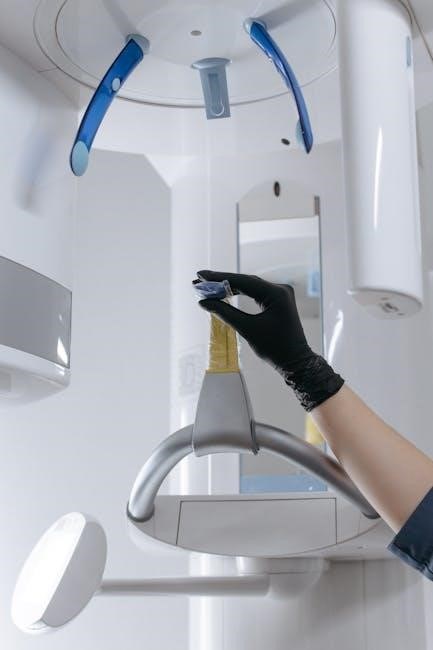
Accessing the Therapeutic Guidelines Oral and Dental Version 3 PDF
The PDF can be accessed via official sources or subscriptions, ensuring authenticity and compliance with licensing terms for free or paid distribution, depending on availability․
How to Download the PDF for Free
Downloading the Therapeutic Guidelines Oral and Dental Version 3 PDF for free is achievable through reputable sources; Visit official websites or academic platforms that offer free access to medical guidelines․ Ensure compliance with copyright laws and licensing agreements to avoid legal issues․ Some institutions provide free access to their members or students․ Additionally, public health organizations may offer downloadable versions for educational purposes․ Always verify the authenticity of the source to ensure the document’s accuracy and reliability․ Be cautious of unofficial sites that may provide outdated or altered content, which could lead to misinformation․ Prioritize official channels to obtain the most current and trustworthy version of the guidelines․
Sources for Reliable Download
Reliable sources for downloading the Therapeutic Guidelines Oral and Dental Version 3 PDF include official publisher websites, academic institutions, and professional dental associations․ Official websites often provide free access to registered users or members․ Academic platforms like university libraries or research databases may offer the PDF for educational purposes․ Professional associations, such as the American Dental Association (ADA) or the British Dental Association (BDS), often provide access to their members․ Additionally, public health organizations and government health departments may host free versions for widespread dissemination․ Always verify the authenticity of the source to ensure compliance with legal and ethical standards․ Avoid unauthorized sites that may offer free downloads illegally, as they could compromise the document’s integrity or violate copyright laws․
Legal and Ethical Considerations for Free Access
Accessing the Therapeutic Guidelines Oral and Dental Version 3 PDF for free requires careful consideration of legal and ethical implications․ Copyright laws protect the document, and unauthorized distribution or downloading may violate these protections․ Users should ensure they obtain the PDF through legitimate sources, such as purchasing it from the publisher or accessing it via authorized platforms․ Sharing or downloading the document without proper authorization can lead to legal consequences․ Ethical considerations also emphasize respecting the intellectual property rights of the creators, who invest significant resources in developing evidence-based guidelines․ Always verify the legality of the source and adhere to copyright regulations to support the continued development of such valuable resources;
Therapeutic Guidelines Oral and Dental Version 3 remains a cornerstone for evidence-based dental care, enhancing patient outcomes․ Future updates will refine recommendations, ensuring continued relevance and excellence in practice․
Significance of Therapeutic Guidelines in Modern Dentistry
Therapeutic Guidelines Oral and Dental Version 3 holds significant importance in modern dentistry by providing evidence-based recommendations that enhance clinical decision-making․ These guidelines ensure standardized, high-quality dental care․
Future Updates and Improvements in Oral and Dental Care
Future updates to Therapeutic Guidelines Oral and Dental will focus on integrating emerging research and advancements in dental technology․ These improvements aim to enhance patient outcomes and streamline clinical practices further․
Encouraging Adherence to Therapeutic Guidelines
Adherence to Therapeutic Guidelines Oral and Dental Version 3 is crucial for maintaining high-quality patient care․ Dental professionals are encouraged to integrate these evidence-based recommendations into daily practice to ensure optimal outcomes․ Regular updates and practical tools provided in the guidelines help clinicians stay informed and compliant․ By fostering a culture of adherence, dental teams can reduce variability in care and improve patient safety․ Continuous education and training on the guidelines are essential for reinforcing their use․ Additionally, free access to the PDF version ensures that all professionals, regardless of their setting, can benefit from these resources․ Encouraging adherence not only enhances individual practice but also contributes to better public health outcomes․
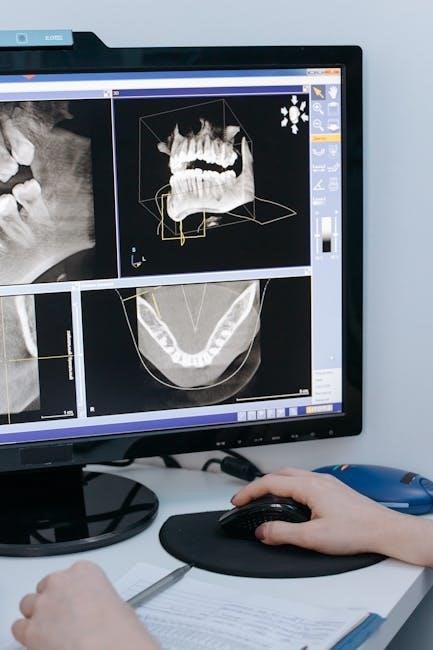


Leave a Reply
You must be logged in to post a comment.